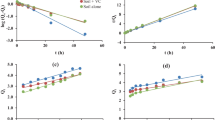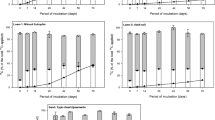Abstract
Purpose
The aim of this work was to study the temporal changes in the sorption–desorption of fungicides in a sandy clay loam soil amended with spent mushroom substrate (SMS) under controlled laboratory conditions and the influence that fungicides properties and soil characteristics have on these processes. Soil amendment with SMS is becoming a widespread management practice since it can effectively solve the problems of uncontrolled SMS accumulation and disposal and improve soil quality. However, when simultaneously applied with pesticides, SMS can significantly modify the environmental behaviour of these compounds.
Materials and methods
Sorption–desorption isotherms of metalaxyl, penconazole, pyrimethanil and iprovalicarb for unamended and amended vineyard soils from La Rioja (Spain) were obtained. Composted SMS (C-SMS) and fresh SMS (F-SMS) from cultivation of different mushrooms were used as amendments at 2 % and 10 % rates. Soil parameters (organic carbon (OC), dissolved organic carbon (DOC), humic acid (HA) and fulvic acid (FA)) and sorption (Kf, nf, Kd, Koc) and desorption (Kfd, nfd, H) parameters of fungicides were determined over 0, 6 and 12 months of soil incubation with SMS under controlled conditions.
Results and discussion
Addition of amendments to soil increased soil sorption capacity of fungicides. Kd values increased with the hydrophobic character of fungicides (metalaxyl < iprovalicarb < pyrimethanil < penconazole) at both amendment rates. The lower content of DOC and the higher degree of OC humification enhanced sorption of all fungicides by the soil + C-SMS with regard to the soil + F-SMS. In general, sorption of fungicides decreased after 6 and 12 months of soil + SMS incubation, although the humification degree of the remaining OC expressed by HA/FA increased. This might indicate that the OC content was more important for fungicide sorption than the changes in its nature with the incubation time. SMS addition favoured desorption of metalaxyl and iprovalicarb, in general, whereas irreversible sorption of penconazole and pyrimethanil increased. However, the opposite trends were observed when the soil + SMS incubation time increased.
Conclusions
The results show an increase in sorption of all fungicides by amending soil with composted or fresh SMS. However, desorption of fungicides increases or decreases depending on the properties of fungicides and soil + SMS. Changes in both processes with the incubation time are more related to the OC content of the amended soil than to the evolution of its nature. These outcomes are of interest for extending SMS application to soil with minimal or no environmental risk when used simultaneously with fungicides.


Similar content being viewed by others
References
Ahmad R, Kookana RS, Alston AM, Skjemstad JO (2001) The nature of soil organic matter affects sorption of pesticides. 1. Relationships with carbon chemistry as determined by 13 C CPMAS NMR spectroscopy. Environ Sci Technol 35:878–884
Andrades MS, Rodríguez-Cruz MS, Sánchez-Martín MJ, Sánchez-Camazano M (2004) Effect of the addition of wine distillery wastes to vineyard soils on the adsorption and mobility of fungicides. J Agric Food Chem 52:3022–3029
Arias-Estévez M, López-Periago E, Martínez-Carballo E, Simal-Gándara J, Mejuto JC, García-Río L (2008) The mobility and degradation of pesticides in soils and the pollution of groundwater resources. Agric Ecosyst Environ 123:247–260
Barriuso E, Baer U, Calvet R (1992) Dissolved organic matter and adsorption-desorption of dimefuron, atrazine, and carbetamide by soils. J Environ Qual 21:359–367
Bremner JM (1996) Nitrogen total. In: Sparks DL (ed) Methods of soil analysis. Part 3—chemical methods. Soil Science Society of America, Madison, pp 1085–1121
Briceño G, Palma G, Durán N (2007) Influence of organic amendment on the biodegradation and movement of pesticides. Crit Rev Environ Sci Technol 37:233–271
Briceño G, Demanet R, Mora MD, Palma G (2008) Effect of liquid cow manure on andisol properties and atrazine adsorption. J Environ Qual 37:1519–1526
Chiou CT, Kile DE, Rutherford DW, Sheng G, Boyd SA (2000) Sorption of selected organic compounds from water to a peat soil and its humic acid and humin fractions: potential sources of the sorption nonlinearity. Environ Sci Technol 34:1254–1258
Chiu SW, Law SCh, Ching M, Cheung KW, Chen MJ (2000) Themes for mushroom exploitation in the 21st century: sustainability, waste management, and conservation. J Gen Appl Microbiol 46:69–282
Clapp CE, Hayes MHB, Senesi N, Bloom PR, Jardine PM (2001) Humic substances and chemical contaminants. Soil Science of America, Madison
Cox L, Fernandes MC, Zsolnay A, Hermosín MC, Cornejo J (2004) Changes in dissolved organic carbon of soil amendments with aging: effect on pesticide adsorption behaviour. J Agric Food Chem 52:5635–5642
Cox L, Velarde P, Cabrera A, Hermosín MC, Cornejo J (2007) Dissolved organic carbon interactions with sorption and leaching of diuron in organic-amended soils. Eur J Soil Sci 58:714–721
de Wilde T, Spanoghe P, Ryckeboer J, Jaeken P, Pringael D (2009) Sorption characteristics of pesticides on matrix substrates used in biopurification systems. Chemosphere 75:100–108
Delgado-Moreno L, Almendros G, Peña A (2007) Raw or incubated olive-mill wastes and its biotransformed products as agricultural soil amendments effect on sorption–desorption of triazine herbicides. J Agric Food Chem 55:836–843
FAOSTAT (2009) Food and Agriculture Organization of the United Nations. http://faostat.fao.org. Accessed 3 August 2011
Fenoll J, Ruiz E, Flores P, Hellín P, Navarro S (2011) Reduction of the movement and persistence of pesticides in soil through common agronomic practices. Chemosphere 85:1375–1382
Fernandes MC, Cox L, Hermosín MC, Cornejo J (2006) Organic amendments affecting sorption, leaching and dissipation of fungicides is soils. Pest Manag Sci 62:1207–1215
Fernández-Bayo JD, Nogales R, Romero E (2009) Assessment of three vermicomposts as organic amendments used to enhance diuron sorption in soils with low organic carbon content. Eur J Soil Sci 60:935–944
Filipe OMS, Vidal MM, Scherer HW, Schneider RJ, Duarte AC, Esteves VI, Santos EBH (2010) Effect of long term organic amendments on adsorption–desorption of thiram onto a luvisol soil derived from loess. Chemosphere 80:293–300
FOOTPRINT (2011) The FOOTPRINT Pesticide Properties Database (PPDB). http://sitem.herts.ac.uk/aeru/footprint/index2.htm, University of Hertfordshire
García Izquierdo C, Lobo Bedmar MC (2008) In: Moreno Casco J, Moral Herrero R (eds) Rehabilitación de suelos degradados y contaminados mediante la aplicación de compost. Compostaje, Mundi Prensa, pp 425–448
Ghosh RK, Singh N (2009) Effect of organic manure on sorption and degradation of azoxystrobin in soil. J Agric Food Chem 57:632–636
Herrero-Hernández E, Andrades MS, Marín-Benito JM, Sánchez-Martín MJ, Rodríguez-Cruz MS (2011) Field-scale dissipation of tebuconazole in a vineyard soil amended with spent mushroom substrate and its potential environmental impact. Ecotox Environ Saf 74:1480–1488
López-Piñeiro A, Cabrera D, Albarrán A, Peña D (2011) Influence of two-phase olive mill waste application to soil on terbuthylazine behaviour and persistence under controlled and field conditions. J Soils Sediments 11:771–782
Luo JM, Liu MC, Zha J, Wang Z (2009) Impacts of particulate organic carbon and dissolved organic carbon on removal of polycyclic aromatic hydrocarbons, organochlorine pesticides, and nonylphenols in a wetland. J Soils Sediments 9:180–187
MAPA (Ministerio de Agricultura, Pesca y Alimentación) (1986) Métodos oficiales de análisis. Dirección General de Política Alimentaría, Madrid
Marin-Benito JM (2011) Dinámica de fungicidas en suelos de viñedo enmendados con substrato postcultivo de hongos. Dissertation. University of Salamanca
Marín-Benito JM, Sánchez-Martín MJ, Andrades MS, Pérez-Clavijo M, Rodríguez-Cruz MS (2009a) Effect of spent mushroom substrate amendment of vineyard soils on the behaviour of fungicides: 1. Adsorption–desorption of penconazole and metalaxyl by soils and sub-soils. J Agric Food Chem 57:9634–9642
Marín-Benito JM, Rodríguez-Cruz MS, Andrades MS, Sánchez-Martín MJ (2009b) Effect of spent mushroom substrate amendment of vineyard soils on the behavior of fungicides: 2. Mobility of penconazole and metalaxyl in undisturbed soil cores. J Agric Food Chem 57:9643–9650
Marín-Benito JM, Rodríguez-Cruz MS, Andrades MS, Sánchez-Martín MJ (2012) Assessment of spent mushroom substrate as sorbent of fungicides: influence of sorbent and sorbate properties. J Environ Qual. doi:10.2135/jeq2011.0437
Miguéns T, Leirós C, Gil-Sotres F, Trasar-Cepeda C (2007) Biochemical properties of vineyard soils in Galicia, Spain. Sci Total Environ 378:218–222
Müller K, Magesan GN, Bolan NS (2007) A critical review of the influence of effluent irrigation on the fate of pesticides in soil. Agr Ecosyst Environ 120:93–116
Nelson DW, Sommers LE (1996) Total carbon, organic carbon and organic matter. In: Sparks DL (ed) Methods of soil analysis. Part 3—chemical methods. Soil Science Society of America Inc, Madison, pp 961–1010
Reichenberger S, Bach M, Skitschak A, Frede HG (2007) Mitigation strategies to reduce pesticide inputs into ground- and surface water and their effectiveness: a review. Sci Total Environ 384:1–35
Rodríguez-Cruz MS, Ordax JM, Arienzo M, Sánchez-Martín MJ (2011) Enhanced retention of linuron, alachlor and metalaxyl in sandy soil columns intercalated with wood barriers. Chemosphere 82:1415–1421
Sánchez L, Romero E, Sánchez-Rasero F, Dios F, Peña A (2003) Enhanced soil sorption of methidathion using sewage sludge and surfactants. Pest Manag Sci 59:857–864
Sánchez-Camazano M, Iglesias-Jiménez E, Sánchez-Martin MJ (1997) City refuse compost and sodium dodecyl sulphate as modifiers of diazinon leaching in soil. Chemosphere 35:3003–3012
Sheng G, Johnson CT, Teppen BJ, Boyd SA (2001) Potential contribution of smectite clays and organic matter to pesticide retention in soils. J Agric Food Chem 49:2899–2907
Soil Survey Staff (2006) Keys to soil taxonomy. United States Department of Agriculture (USDA), Natural Resources Conservation Service, Washington DC
Spokas KA, Koskinen WC, Baker JM, Reicosky DC (2009) Impacts of woodchip biochar additions on greenhouse gas production and sorption/degradation of two herbicides in a Minnesota soil. Chemosphere 77:574–581
Stevenson FJ (1982) Humus chemistry. Genesis-composition-reactions. John Wiley and Sons, New York
Tomlin CDS (2000) The pesticide manual. British Crop Protection Council, Cambridge
Wang H, Lin K, Hou Z, Richardson B, Gan J (2010) Sorption of the herbicide terbuthylazine in two New Zealand forest soils amended with biosolids and biochars. J Soils Sediments 10:283–289
Wauchope RD, Yeh S, Linders JBHJ, Kloskowski R, Tanaka K, Rubin B, Katayama A, Kördel W, Gerstl Z, Lane M, Unsworth JB (2002) Pesticide soil sorption parameters: theory, measurement, uses, limitations and reliability. Pest Manag Sci 58:419–445
Wuest PJ, Levanon D, Hadar Y (1995) Environmental, agricultural and industrial uses for spent mushroom substrate from mushroom farms. JG Press, Emmaus
Zhang W, Xu M, Wang X, Huang Q, Nie J, Li Z, Li S, Hwang SW, Lee KB (2012) Effects of organic amendments on soil carbon sequestration in paddy fields of subtropical China. J Soils Sediments. doi:10.1007/s11368-011-0467-8
Acknowledgments
This work was funded by the Spanish Ministry of Education and Science under project AGL2007-61674/AGR. J.M. Marín-Benito thanks Spain’s Research Council (CSIC) for his JAE-Pre-doctoral fellowship cofinanced by European and Structural and Social Funds (FEDER-FSE). We would like to thank L.F. Lorenzo, J.M. Ordax and A. Gonzalez for their technical help and CTICH and INTRAVAL S.L. from La Rioja, Spain, for their collaboration.
Author information
Authors and Affiliations
Corresponding author
Additional information
Responsible editor: Jay Gan
Rights and permissions
About this article
Cite this article
Marín-Benito, J.M., Andrades, M.S., Rodríguez-Cruz, M.S. et al. Changes in the sorption–desorption of fungicides over time in an amended sandy clay loam soil under laboratory conditions. J Soils Sediments 12, 1111–1123 (2012). https://doi.org/10.1007/s11368-012-0525-x
Received:
Accepted:
Published:
Issue Date:
DOI: https://doi.org/10.1007/s11368-012-0525-x




